Различные способы создания Pandas Dataframe
Pandas DataFrame - это двумерная помеченная структура данных со столбцами потенциально разных типов. Обычно это наиболее часто используемый объект pandas.
Pandas DataFrame можно создать несколькими способами. Давайте обсудим разные способы создания DataFrame один за другим.
Method #1: Creating Pandas DataFrame from lists of lists.
# Import pandas libraryimport pandas as pd # initialize list of listsdata = [["tom", 10], ["nick", 15], ["juli", 14]] # Create the pandas DataFramedf = pd.DataFrame(data, columns = ["Name", "Age"]) # print dataframe.df |
Выход:
Метод # 2: Создание DataFrame из наррея / списков
To create DataFrame from dict of narray/list, all the narray must be of same length. If index is passed then the length index should be equal to the length of arrays. If no index is passed, then by default, index will be range(n) where n is the array length.
# Python code demonstrate creating # DataFrame from dict narray / lists # By default addresses. import pandas as pd # intialise data of lists.data = {"Name":["Tom", "nick", "krish", "jack"], "Age":[20, 21, 19, 18]} # Create DataFramedf = pd.DataFrame(data) # Print the output.df |
Output: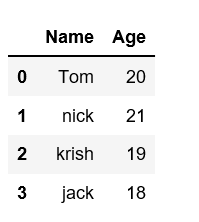
Method #3: Creates a indexes DataFrame using arrays.
# Python code demonstrate creating # pandas DataFrame with indexed by # DataFrame using arrays.import pandas as pd # initialise data of lists.data = {"Name":["Tom", "Jack", "nick", "juli"], "marks":[99, 98, 95, 90]} # Creates pandas DataFrame.df = pd.DataFrame(data, index =["rank1", "rank2", "rank3", "rank4"]) # print the datadf |
Выход:
Метод # 4: Создание Dataframe из списка dicts
Pandas DataFrame can be created by passing lists of dictionaries as a input data. By default dictionary keys taken as columns.
# Python code demonstrate how to create # Pandas DataFrame by lists of dicts.import pandas as pd # Initialise data to lists.data = [{"a": 1, "b": 2, "c":3}, {"a":10, "b": 20, "c": 30}] # Creates DataFrame.df = pd.DataFrame(data) # Print the datadf |
Выход: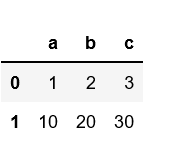
Другой пример создания pandas DataFrame путем передачи списков словарей и индексов строк.
# Python code demonstrate to create# Pandas DataFrame by passing lists of # Dictionaries and row indices.import pandas as pd # Intitialise data of lists data = [{"b": 2, "c":3}, {"a": 10, "b": 20, "c": 30}] # Creates padas DataFrame by passing # Lists of dictionaries and row index.df = pd.DataFrame(data, index =["first", "second"]) # Print the datadf |
Выход: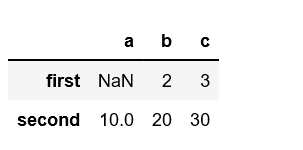
Another example to create pandas DataFrame from lists of dictionaries with both row index as well as column index.
# Python code demonstrate to create a# Pandas DataFrame with lists of # dictionaries as well as # row and column indexes. import pandas as pd # Intitialise lists data.data = [{"a": 1, "b": 2}, {"a": 5, "b": 10, "c": 20}] # With two column indices, values same # as dictionary keysdf1 = pd.DataFrame(data, index =["first", "second"], columns =["a", "b"]) # With two column indices with # one index with other namedf2 = pd.DataFrame(data, index =["first", "second"], columns =["a", "b1"]) # print for first data frameprint (df1, "
") # Print for second DataFrame.print (df2) |
Output: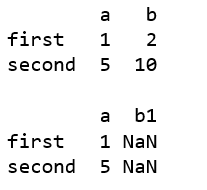
Method #5: Creating DataFrame using zip() function.
Two lists can be merged by using list(zip()) function. Now, create the pandas DataFrame by calling pd.DataFrame() function.
# Python program to demonstrate creating # pandas Datadaframe from lists using zip. import pandas as pd # List1 Name = ["tom", "krish", "nick", "juli"] # List2 Age = [25, 30, 26, 22] # get the list of tuples from two lists. # and merge them by using zip(). list_of_tuples = list(zip(Name, Age)) # Assign data to tuples. list_of_tuples # Converting lists of tuples into # pandas Dataframe. df = pd.DataFrame(list_of_tuples, columns = ["Name", "Age"]) # Print data. df |
Выход: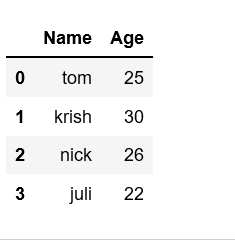
Метод №6: Создание DataFrame из Dicts серии.
To create DataFrame from Dicts of series, dictionary can be passed to form a DataFrame. The resultant index is the union of all the series of passed indexed.
# Python code demonstrate creating# Pandas Dataframe from Dicts of series. import pandas as pd # Intialise data to Dicts of series.d = {"one" : pd.Series([10, 20, 30, 40], index =["a", "b", "c", "d"]), "two" : pd.Series([10, 20, 30, 40], index =["a", "b", "c", "d"])} # creates Dataframe.df = pd.DataFrame(d) # print the data.df |
Выход: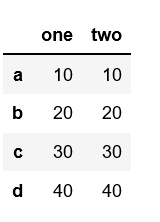
Внимание компьютерщик! Укрепите свои основы с помощью базового курса программирования Python и изучите основы.
Для начала подготовьтесь к собеседованию. Расширьте свои концепции структур данных с помощью курса Python DS. А чтобы начать свое путешествие по машинному обучению, присоединяйтесь к курсу Машинное обучение - базовый уровень.